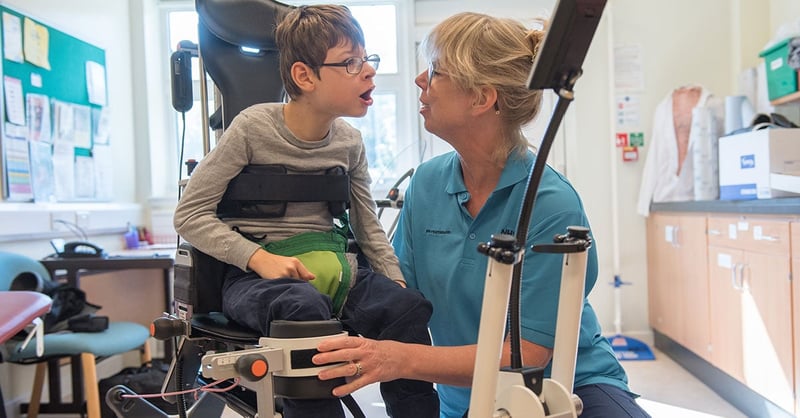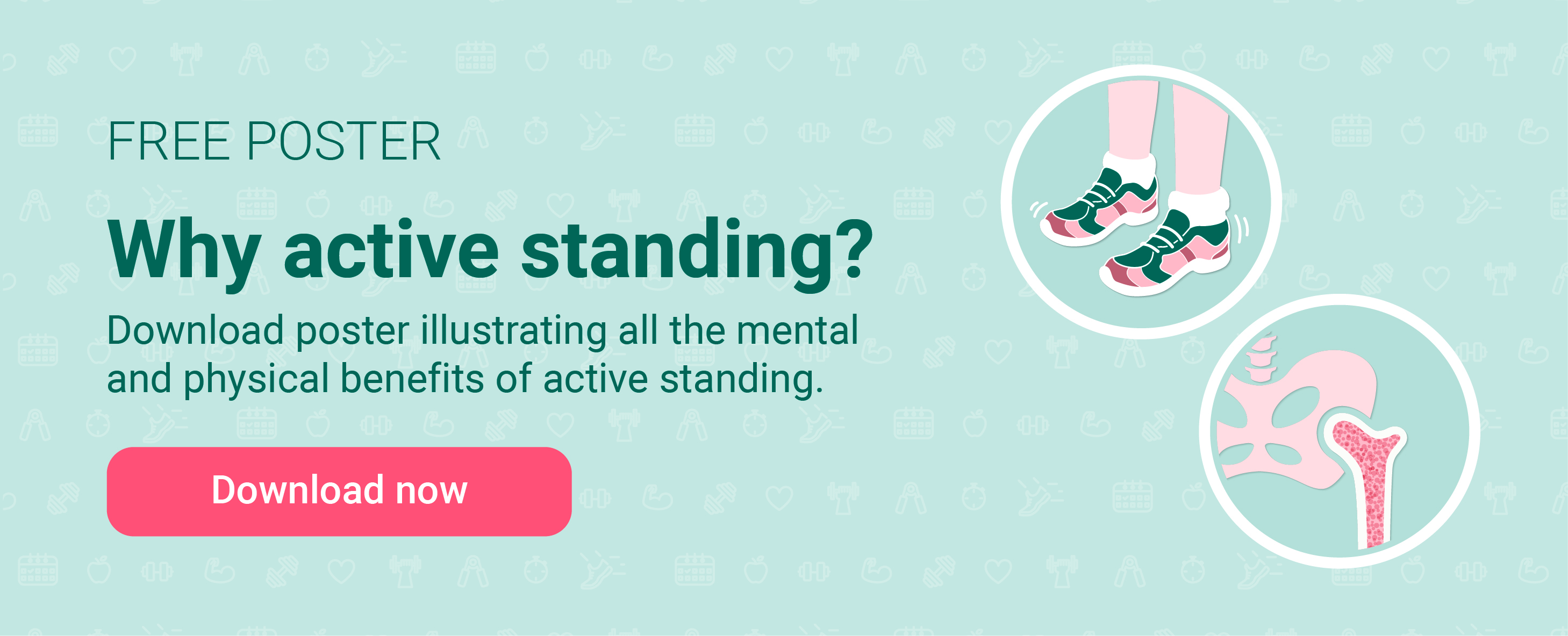Innowalk Pro study shows key outcomes in special school


This is the first study including the Innowalk Pro in a special school setting in the United Kingdom. It included both children from primary and secondary school. They used the Innowalk Pro, a robotic rehabilitation trainer as an adjunction with usual physiotherapy care over a 6-week period.
The study included 27 children diagnosed with Cerebral Palsy (CP), GMFCS IV and V, mean age 12.7 (± 4.0). The author of the study concludes that a 6-week course of movement therapy using the Innowalk Pro can improve:
- quality of life (CPCHILD)
- function goals (GAS)
Introduction
Children with cerebral palsy (CP) often face significant challenges when it comes to physical activity and exercise. However, an active lifestyle is recommended for children with CP, as it is likely to improve their overall health, physical function, and quality of life. Unfortunately, accessibility to equipment can be challenging especially for those who are unable to stand, transfer, or walk unaided.
Research has shown that there are strong associations between poorer parent-reported quality of life (QoL) and higher severity of motor impairments in the domains of physical wellbeing for children with CP. Additionally, children with significant physical impairments often also have issues related to pain and physical wellbeing. Physiotherapy management of children with CP focuses on improving and maintaining gross motor function, activities of daily living, and preventing secondary complications such as contractures and deformities.
Robot-assisted therapies, such as the Innowalk Pro, have evolved over the last 15 years and are improving equity of access to therapy, since they include adjustable settings for differences in children's range of movement (ROM), tone, and functional ability. Innowalk Pro is differentiated from other robot-assisted devices by its small footprint and ability to easily transport from different spaces, such as a classroom within a school setting.
Emerging evidence suggests that using robot-assisted devices can lead to improvements in quality of life reported by parents and children and may improve range of motion in joints, affect spasticity and functional goals.
What is the Innowalk Pro?
The Innowalk PRO is a unique, adjustable solution that enables people with moderate to profound physical disabilities to access movement and physical activity. It provides safe, guided, repetitive movement, close to normal gait, by supporting the body in an upright position with weight bearing.
The equipment ca be used in a school setting, rehabilitation centres and therapy clinics. Learn more about the Innowalk Pro here.
You can find the full article “The ‘heROIC’ trial: Does the use of a robotic rehabilitation trainer change quality of life, range of movement and function in children with cerebral palsy?” by Clare Grodon et al. published in the peer review journal Child: care, health and development here.
To give you a brief overview of the study, here’s an article summary:
Aim of the study
The study aims to explore the effects of using the Innowalk Pro in a special school setting as an adjunct to usual physiotherapy care, measuring:
- Quality of life (QoL) – Primary outcome
- Range of motion of the lower limbs (ROM) – Secondary outcomes
- Spasticity of the lower limbs – Secondary outcomes
- Functional Goals (GAS) – Secondary outcomes
Methods and participants
The study was conducted as a single-centre, single-arm prospective pre-post study at a special school in London.
A single-centre, single-arm prospective pre-post study
- Observational study
- Participants receive an intervention and is assessed before and after the intervention
- Single-centre means that all participants are recruited from the same institution
- Single-arm means that there is no control group
In the intervention period the students used the Innowalk Pro 30 min per day, four times a week for 6 weeks in adjunction to their usual physiotherapy care. Pre and post the intervention period, the students received their usual physiotherapy care.
Participants
- 27 participants diagnosed with CP, GMFCS IV (n=15) and V (n=12)
- Mean age 12.7 years (±4.0)
Of the 27 students included in the study, two did not complete the first phase of the intervention, due to absence from school and one child where unable to complete the two follow-up assessments due to illness.
Outcome measurements
Quality of life was measured with the CPCHILD. The questionnaire was completed independently by participants’ parents at each time point. ROM and spasticity were taken in accordance with the CPIP-UK standardised assessment protocol using a goniometer and the Modified Tardieu Scale (MTS). Individual functional goals were set in collaboration with participant, parents, physiotherapist and teachers using the Goal Attainment Scale (GAS).
All measurements were taking at four time points: before intervention, directly after 6 weeks of intervention, 6 weeks post the intervention and 3 months post intervention.

Results
The results showed a statistically significant improvement in Quality of Life immediately post-intervention, which further improved after 6 weeks and was maintained above pre-intervention levels after 3 months. Analysing subcomponents of the CPCHILD showed that the biggest changes were in component 2, positioning, transferring and mobility and component 3, comfort and emotions.
There were no clinically meaningful changes in joint ROM and spasticity of the lower limbs immediately post intervention. Nevertheless, six participants improved their knee joint range and four participants improved their ankle range pre-post intervention. The improvements in ROM for these participants where not maintained 3 months post intervention.
Functional goals measured with GAS showed significant improvements immediately post-intervention for 88% of the participants. Some participants’ function goals declined when not using the Innowalk Pro after 6 weeks and 3 months.
Conclusion
The study indicates that use of the Innowalk Pro over a period of 6-weeks can enhance the quality of life and functional goals for children with CP aged 5-18 years. The authors did not find significant changes in ROM or spasticity. It also demonstrated that taking a break of 6-12 weeks after using the Innowalk Pro, functional goals tend to return to baseline level. This study is the first of its kind to showcase the potential benefits of using the Innowalk Pro in a school setting in the UK, which could significantly enhance the quality of life and functional goals for children and young people with CP.
For more in-depth knowledge and details we encourage you to read the full article.

Rikke Damkjær Moen brings many years of experience as clinical physiotherapist to the Made for Movement team. Her mission is to ensure that everybody, regardless of mobility problems, should be able to experience the joy and health benefits of physical activity. As our Medical Manager, Rikke is passionate about sharing knowledge so that individuals with special needs, families, and clinicians can discover the possibilities and solutions provided by Made for Movement.
A severe accident during a hockey game resulted in 35-year-old Tobias breaking his neck and becoming paralysed from the armpits down....
A disability entails the loss of, damage to, or deviation from bodily or psychological functions, in the form of mental, physical,...
The Neurological Interdisciplinary Treatment Centre NiB (Neurologisches Interdisziplinäres Behandlungszentrum) is an innovative...
Hear from us from time to time and learn new things
